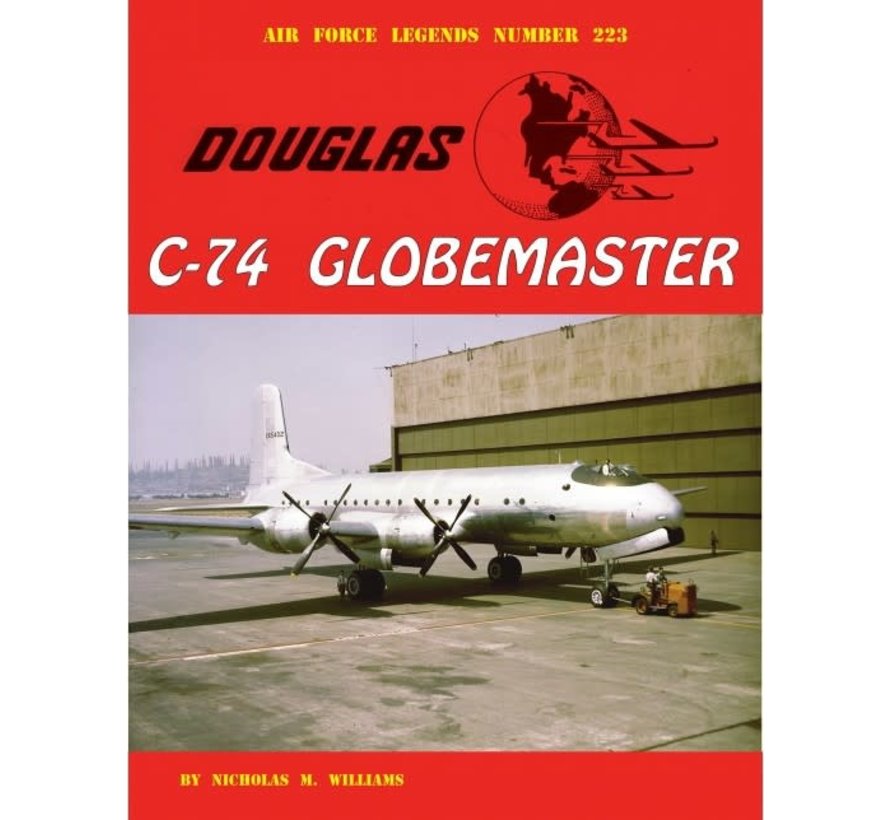Douglas C74 Globemaster: Air Force Legends AFL #223 softcover
Douglas C-74 Globemaster: Air Force Legends AFL #223 softcover
The Japanese attack on Pearl Harbor in December 1941 brought U.S. Army Air Corps strategists to the realization that a new global transport was needed to carry large loads over great distances. The Douglas Aircraft Company in Santa Monica, California, also quickly saw this need and design studies were begun immediately on an expanded version of the company’s DC-4. The “C-74 Project Group” adopted a design philosophy to produce a “no frills” transport able to accommodate at least two of the Army’s T-9 tanks, two 105mm Howitzers, or two angle dozers.
Douglas contacted the Air Corps early in 1942 to determine their interest and a letter of intent was issued in March 1942 for procurement of the Model 415A, now designated the C-74. A contract of over $50 million was signed in June 1942 for fifty airplanes. To speed its delivery to operational units, the C-74 was designed to be released without the benefits of an experimental or prototype model, all aircraft being designated as C-74s with design features following conventional “state-of-the-art” practice. Originally, powered by Wright R-3350 engines, a decision was made in March 1943 to switch to the new, mammoth Pratt & Whitney R-4360 Wasp Major.
The first C-74 was rolled out in July 1945 from the Douglas Long Beach factory. At rollout, the C-74 was the largest land-based transport in the world with a wingspan of 173 feet, length of 124 feet, and gross weight of 145,000 pounds. Able to carry 125 passengers, the C-74 was called the Globemaster as its 11,100-gallons of internal fuel gave it a maximum range of over 7,000 miles, enabling it to circumnavigate the world with only two refueling stops. In its final form, the C-74 was a remarkably efficient airplane, using a semi-laminar flow airfoil for its wings with a full-span flap arrangement. The pilots were enclosed by two teardrop-shaped, double-bubble canopies that provided them with a 360-degree view.
Douglas had every intention of adapting the C-74 into a civil airliner once hostilities had ended. In 1944 Pan American World Airways ordered 26 examples of the civil version, the DC-7, for a route expansion program into Latin America. However, further development of this DC-7 design increased its gross weight to 162,000 pounds and the unit cost to $1.4 million and Pan American cancelled its order in October 1945, opting for smaller transports.
The first C-74, 42-65402, made its maiden flight from Long Beach in September 1945, but with the end of World War II, most of the C-74 production order was cancelled and only 14 Globemasters were built. Unfortunately, during contractor demonstration flights the second Globemaster crashed. The fourth C-74 was subsequently diverted for static tests and its components tested to destruction at Wright Field, Ohio. Beginning in September 1946, the remaining twelve C-74s were flown for the next nine years by the Army Air Forces’ Air Transport Command and the U.S. Air Force’s Military Air Transport Service.
Once in service, the C-74 Globemaster, based first in Memphis, Tennessee, then Morrison Field, West Palm Beach, Florida, finally at Brookley AFB, Mobile, Alabama, set many records for tonnage carried. In November 1949, a C-74 flew the Atlantic to England with a record 103 passengers aboard. One Globemaster set several records during the Berlin Airlift, averaging over 38,000 pounds of cargo and setting a new Airlift Task Force utilization record by flying 20 hours in a 24-hour period. Until one C-74 was converted to the prototype C-124A and the Globemaster II became available, the C-74 was the only Air Force transport capable of carrying outsized cargo.
After the C-74’s retirement from service in 1955, several were purchased surplus and began flying for a contract air carrier, Aeronaves de Panama, hauling prize cattle from Denmark to the Middle East, horses to Singapore, and ships’ parts and vegetables throughout Europe. Unfortunately, after the tragic crash in 1963 of one C-74 in Marseilles, France, the airline suspended operations and its C-74s eventually were scrapped. Today, no examples of this record-setting transport exist.
This monograph of the C-74 Globemaster is written by Nick Williams, an award-winning author of over two dozen articles published in the Journal of the American Aviation Historical Society and publications in the U.K. Nick has written two previous books in Steve Ginter’s Naval Fighters series as well as his 1999 book published in the U.K., “Aircraft of The Military Air Transport Service 1948-1966”. His new book on the C-74 is the result of nearly fifty years of research, containing comments from several of the C-74’s engineers as well as former Douglas and Air Force pilots.
Published 2020, 104 pages, 141 black & white and 35 color photos, 22 illustrations, model kit reviews, softcover, 8 1/2" x 11"
Air Force Legends Series
The Air Force Legends series are dedicated to preserving America's aviation history. Each monograph's size is dictated by the individual aircraft's own history, and in some cases can encompass several volumes. In addition to the aircraft's development and testing, each book covers squadron histories, insignias, flight and maintenance manual excerpts, sea stories, if applicable, and model reviews. Take a look inside the aircraft to see how they were put together. See the prototypes of the aircraft, some of which never made it off the drawing boards.
Ginter Books are for both the aviation enthusiast and the aviation modeler. Each publication seeks to present full information about the history of the aircraft, drawings and photographs of the interiors as well as exteriors, and many of the many color schemes used by the squadrons. This offers both the modeler and the historical customer a general reference guide to each aircraft. The collection of books includes many prototype models that never reached actual production, but were valuable stepping stones in advancing the technology necessary to achieve the modern naval fighters we have today.
These books are a "must" for any serious model builder as they give panel lines, wing-folds, bomb loads, cockpit detail and much more information via line drawings and photographs. They are also a "must" for the aviation history buff, as they detail the conception of these aircraft.
Photos used have come from a great variety of sources that are credited in their captions. Many photos have not been used in any other publications before.
To be advised when an item arrives in stock please use our stock notification tool on the website. When viewing an item on the site, open the green button which says “Send Me An Email When It Arrives” and enter your address. Please Note, this DOES NOT reserve a copy of the item for you. We recommend you order the item As Soon As Possible if you receive a notification, because in some cases very limited stock may be available. Online orders are the fastest way to do this.
You can also contact us at [email protected] or 416-674-5959 to reserve your copy.






